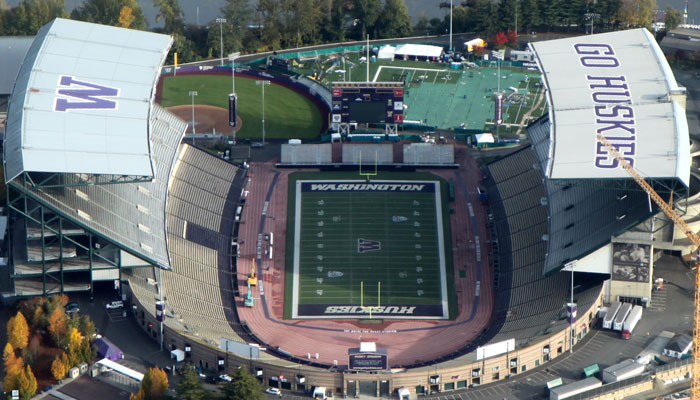Husky Stadium

Husky Stadium, located on the University of Washington campus in Seattle, Washington, is a multipurpose stadium primarily used for American football, but it also houses a state-of-the-art swimming stadium. The swimming stadium has a rich history, dating back to the 1920s.
History of Swimming Stadiums:
In the early 20th century, many cities in the United States began constructing swimming stadiums as a way to promote public health and wellness. These swimming stadiums were typically large, open-air structures that could hold thousands of people. They were used for both recreational and competitive swimming, and they often featured diving boards and other amenities.
One of the most famous early swimming stadiums was the Los Angeles Coliseum, which was built in 1923 and held the 1932 and 1984 Olympic Games swimming competitions. Another notable swimming stadium was the Indiana University Natatorium, which was built in 1982 and has hosted numerous major swimming events, including the NCAA Championships and the U.S. Olympic Trials.
Dimensions:
The Husky Swimming Stadium is a world-class facility with a length of 50 meters and a width of 25 meters. It has a depth of 9 feet in the diving well and a depth of 6 feet in the competition pool. The stadium can accommodate up to 1,500 spectators, and it features a state-of-the-art scoreboard and timing system.
Capacity:
As previously stated, the swimming stadium at Husky Stadium can hold up to 1,500 spectators. The facility also has ample space for competitors, coaches, and officials, as well as a variety of amenities for athletes, such as locker rooms, training rooms, and equipment storage.
Capacity:
As previously stated, the swimming stadium at Husky Stadium can hold up to 1,500 spectators. The facility also has ample space for competitors, coaches, and officials, as well as a variety of amenities for athletes, such as locker rooms, training rooms, and equipment storage.
Architecture:
The swimming stadium at Husky Stadium is an impressive feat of modern architecture. It features a sleek, modern design that blends seamlessly with the overall aesthetic of the stadium. The facility is constructed of concrete and steel, with large, curved walls and a glass facade that allows for plenty of natural light.
Technology:
The Husky Swimming Stadium is equipped with the latest in swimming technology, including a state-of-the-art timing system and electronic scoreboards. The facility also features an underwater camera system that allows coaches and swimmers to analyze their technique and performance.
Facilities:
In addition to the competition and diving pools, the Husky Swimming Stadium features a variety of other amenities, including a weight room, a training room, and a sauna. The facility also has locker rooms for athletes and coaches, as well as a conference room and a media room.
Track surface:
While the swimming stadium at Husky Stadium doesn't feature a track surface, the surrounding football stadium does. The track at Husky Stadium is a six-lane, 400-meter track that is made of polyurethane.
Field events:
The football stadium at Husky Stadium is also home to a variety of field events, including the long jump, high jump, and shot put. The stadium features a variety of throwing and jumping areas, as well as a large, grassy field for other events.
Events and competitions:
The Husky Swimming Stadium has hosted a variety of major swimming events, including the NCAA Championships and the U.S. Olympic Trials. The facility is also used for a variety of other events, including concerts and community gatherings.
Safety:
Safety is a top priority at the Husky Swimming Stadium. The facility is equipped with state-of-the-art safety systems, including lifeguards and emergency equipment. Additionally, all swimmers are required to follow strict safety protocols, including wearing appropriate swimwear and following all posted rules and regulations.
Sustainability:
The University of Washington is committed to sustainability, and the swimming stadium at Husky Stadium is no exception. The facility is designed to be energy-efficient and environmentally friendly, with features such as energy-efficient lighting and low-flow plumbing fixtures. The stadium also utilizes a rainwater collection system to irrigate the surrounding landscape.
In addition, the university has implemented a variety of sustainability initiatives, such as recycling and composting programs, to reduce waste and promote environmental responsibility.
Overall, the Husky Swimming Stadium is a world-class facility that embodies the University of Washington's commitment to excellence in athletics and sustainability. With its state-of-the-art technology, modern design, and commitment to safety and sustainability, the facility is sure to continue hosting major swimming events for years to come.




